When it comes to grooming the Keeshond coat, it is important to know there are a variety of coat types within today's breed specimens. They range all the way from a very soft coat that has a tendency to matt easily, but looks great when freshly groomed, to a coat that is extremely harsh, verging on feeling and looking more like a brillo pad, which has a tendency to be dry and brittle and break off easily when groomed without using a grooming spray. I prefer a coat that falls in the middle of these two extremes. It tends to be the straightest coat, has a noticeably coarse guard coat as opposed to the soft, downy undercoat, but is not kinky like the extremely coarse coats. This type of coat maintains its good looks weeks after being groomed and can be returned to a freshly groomed look by running a pin brush through the coat on a weekly basis. We have dogs that fall into different coat type categories, but my favorites, by far, are the ones like Winston's that are neither too soft nor too coarse.The soft coat will require more frequent brushing, to avoid tangles and matts. It is best to comb through this type of coat at least once a month and to run a pin brush through it on a weekly basis. The harsh, coarse coat type will require the use of a coat conditioning spray, in order to prevent the breakage of the coat, during combing and brushing. The mid-range coat texture is very resistant to breakage and can be maintained by running a pin brush through it once every week or two and should be combed out at least once every two months. This coat type can actually go for several months with just the brush out without forming tight matts.No matter the texture of the coat, some sort of liquid spray should be used on the coat during the grooming process, whether it be simply water or some type of conditioner. This will prevent the coat from breaking off. One product that works well for this purpose is Chris Christensen's Silk Spirits, which is applied to the coat with your hands, instead of in spray form.
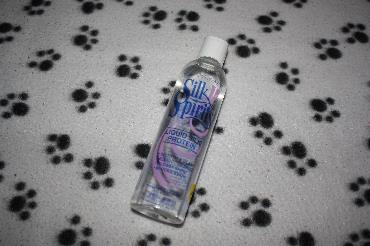
The choice of grooming tools is very personal and often depends on what is the most comfortable to the user. It is best to use a pin brush to run through the coat, in order to initially separate the hairs. For the Keeshond coat, you should use a brush with pins somewhere in the 1 1/2" to 2" range, like the Chris Christensen pin brush that I use. No matter what brand you use, make sure the tips of the pins are polished instead of having rough edges, to prevent scratching the dog's skin during brushing. This is also true of whatever comb you choose. I use an assortment of combs that include Greyhound style combs with a tooth spread of about 1/8" on one side and 1/4" on the other with teeth that are about 1 1/2" long, and combs that incorporate a handle that are more comfortable to use for long grooming sessions. I use one such comb with a tooth spread of about 3/8" with teeth that are about 2" long to get between the coat and the skin and pull out loose, shedded coat. This type of comb will loosen matted areas much easier than combs with shorter, and closer set teeth. There are also combs called rakes that will loosen and pull out shedded undercoat. They resemble a rake like you use for raking leaves, thus the name. Your choice on which of these tools to use depends on what is the most comfortable for you.
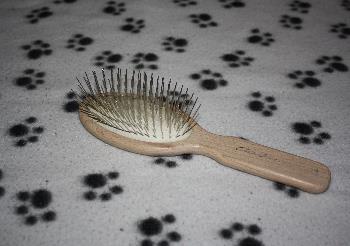
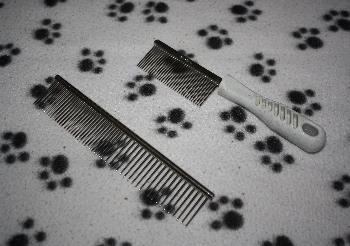
Another tool that can come in quite handy is a matt breaker. There are several types, but the common design is a handle style tool with a row of razor blade teeth that will literally cut through matts. The tips of these tools are typically rounded to keep you from being able to stab the dog while using. Use extreme care with these tools, but they make it very easy to remove those pesky matts that tend to form behind a Keeshond's ears.I also like to keep a small slicker brush on hand for removing poop residue and "dingle berries" from a Keeshond's back end without having to cut them out or bathe the dog. All you have to do is sprinkle some baby powder or cornstarch on the area, then gently brush it out using the small slicker brush. In this manner, you can clean up a dirty back side without the trouble of bathing the dog or the unsightliness of using scissors to cut out coat.
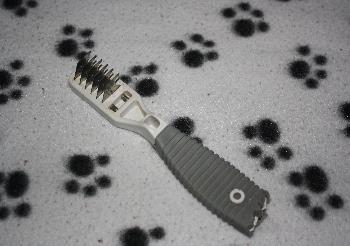
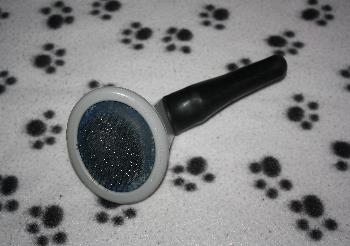
It is very important to keep on top of trimming your dog's nails on a regular basis, unless the dog is walked on a hard, rough surface like concrete on a frequent basis. Nails that grow too long will interfere with the dog's natural gait and can cause a variety of toe and foot problems. To avoid cutting the quick on your dog, only remove a small section of the tip of the nail at a time. If you are unsure how much to remove, it is best to consult a vet or groomer and have them instruct you on the amount that can be safely cut. The other option is to take off no more than 1/8" at a time and trim them about every 4-5 days until they are at the proper length and then keep up the trimming once a week from that point on. Performing nail trims in this manner will allow you to cut the nails shorter and shorter without cutting the quick, since the quick will eventually recede into the nail a bit with each trimming. It is always best to keep some sort of blood clotting product, otherwise known as styptic powder, on hand, just in case you take off too much and cut into the quick. I use Kwik Stop brand, but there are numerous brands from which to choose.
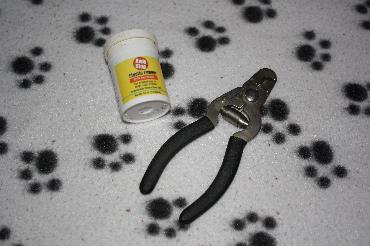
You may wish to clean your Keeshond's ears and brush their teeth to complete the overall grooming regimen. To clean the ears, simply take a cotton ball and apply a few drops of an ear cleaner to dampen it and gently wipe the inside of the ear canal as far down as you can comfortably go. It is advisable to pack your dog's ears with cotton during bathing, to keep water from entering the ear canal, which can lead to ear infections. Just remember to remove them after the grooming session is over! Brushing your dog's teeth on a regular basis can prevent you from having to have their teeth cleaned by your veterinarian as often. I use a tooth brush that has three heads that surround the tooth, so that you are cleaning all surfaces with one brush stroke. I use a tooth gel for dogs that I apply to the brush and then brush along all of the dog's teeth all the way to the back of the mouth. Never use human toothpastes, since they have ingredients that are dangerous to dogs. Tooth decay in a dog can lead to infection that can migrate to the dog's organs and eventually lead to disease and even death, so it is crucial to keep on top of dental hygiene in order to give your companion the best odds for a long, happy life.
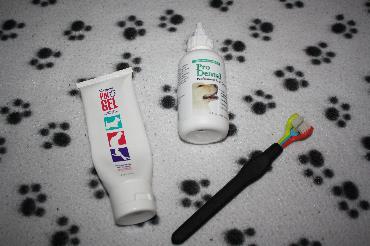
One more piece of equipment that can make grooming breeds like the Keeshond a breeze is a high velocity dryer. One of the most popular brands is the orange Metro dryer, but I use the black Master Blaster, which is considerably more powerful and will blow the vast majority of the shedded coat out of the dog, saving time and energy during the brushing and combing phase of the grooming. I go over the dog with a pin brush first and identify any actual matts, which I will remove using a combination of a comb, slicker brush (if necessary) and the matt breaker (also, if necessary). At this point, I do not concern myself with removing the loose coat, just making sure there are no tangles. I then bathe the dog and then dry the dog with the high velocity dryer. You should first run the dryer over the entire dog to remove most of the water, so that the dog is not "dripping" wet. Then start in one section and blow the coat dry holding the nozzle just a few inches from the skin. This will loosen shedded coat and cause the hairs to "spider web" out until they fly away from the coat. Blowing the coat against the lay of the coat, e.i. blowing the hair down the dog's back toward the head, will make the coat stand off from the body and give the best finished result. While you are drying the dog, you can check the condition of the dog's skin and pinpoint any sores or growths that require veterinary attention. Drying your dog in this manner will also lessen, if not eliminate, the risk of the dog developing hot spots, as long as you dry them thoroughly. Any dampness that remains in the coat can lead to hot spots in humid environments. Here in Colorado, hot spots are not typically a problem, since the dry climate will suck the moisture out of the coat rather quickly. We have the opposite problem of having to use coat conditioners in order to maintain enough moisture to be able to groom the coat without breaking it. One drawback to using these types of dryers is that many dogs have some fear of the high velocity air being blown on them and will try to escape, until they become accustomed to the air and noise, which will eventually happen. For this reason, it is best to have a grooming table with a grooming arm and noose to secure the dog, so that they may not escape your control. You should always have one hand on the dog at all times while drying them in this manner, until they become accustomed to the routine. Never, never leave your dog on the table in the noose, unattended. Dogs have died in this manner, even under the supervision of professional dog show handlers, so it is not worth taking the chance. Once the dog is dry, mist with water or conditioner and run the pin brush through the coat once more in order to separate the coat initially. Then, beginning at the bottom of the dog, line comb the coat thoroughly by holding the coat up with one hand and pulling a small amount of coat out from under your hand with the comb, making sure you comb it through completely. Once you have gone over the entire dog in this manner, the coat should remain in good shape for weeks to come with minimal brushing on a weekly basis.The final touch to a well groomed Keeshond is to trim the feet, hocks and pasterns. This is a difficult thing to describe and really needs to be demonstrated. I plan to make a video demonstrating my technique, so look for that at a future date. The best results will be attained by using a pair of curved scissors and a pair of thinning shears. You want to carefully trim the hair on the bottom of the feet to be flush with the pads. You may trim the hair from in between the pad and the toes, but be very careful not to cut the tender flesh in that area and not to nick the pads of the feet, as they bleed profusely and it is difficult to stop the bleeding, even with Kwik Stop. I do this trimming by holding the foot upside down so that I am looking at the pad. I then proceed to trim the hair around the outsides of the foot just enough to give the foot a rounded shape. I trim the hair at the very front of the foot to where it is flush with the front of the toes, both below, above and around the nails. This will make the foot look more compact. After rounding the foot, I work from the top of the foot and use a very small comb to comb the hair backwards, using the end teeth of the comb to pull the hair from between the toes and comb it backwards so that it stands up. I then take a small pair of thinning shears and, looking from the side of the foot, I sculpt the standing hair so that it blends in with the shorter hairs of the foot and I shape it to give the cat-like appearance that is desired. When completed, the foot will look natural and cat-like and very tidy.The pasterns are the section of the front foot you would compare to the wrist in a human, the part below the nonfunctional toe that is located an inch or so up the back of the front legs from the pad of the foot. To trim this section, merely comb the hair upward so it stands off from the body and use the thinning shears to even up the hairs that stick out from the rest of the coat. You are not looking to take off length, merely even out the coat.The hocks are trimmed in the same manner as the pasterns. Simply comb the hairs upward so that they stand off from the hock portion of the back legs and take the thinning shears and even up the coat by trimming any hairs that stick out from the rest of the coat. With the pasterns and hocks you are only looking to tidy the coat, not actually take off length.
I hope these hints have been helpful. If you have any questions I may answer, please e-mail me at info@keelypso.com. Good luck with your grooming experience and try to make it as pleasurable as possible for your Keeshond!
Cindy Frederiksen, Professional Pet Groomer
Chris Christensen pin brush
Creyhound comb & handle style comb
Mat breaker
Small slicker brush
Nail trimmers & styptic powder
Canine tooth gels & 3 sided toothbrush
Chris Christensen's Silk Spirits
Grooming Tips







